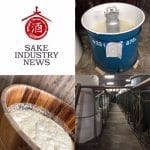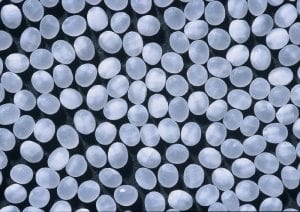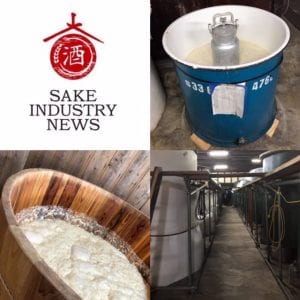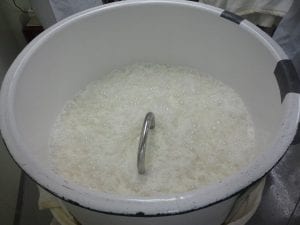This post is a sample from Issue #37 of Sake Industry News. Each issue of SIN has a handful of current news stories and reports, and one technical article written by John Gauntner. It is published on the 1st and the 15th of each month, and includes an audio version of the content as well. A one-year subscription is US$100, or US$10 a month. Subscribe with no risk, since your first two issues are free, and you can cancel with no obligation. Learn more and subscribe here.
written by John Gauntner. It is published on the 1st and the 15th of each month, and includes an audio version of the content as well. A one-year subscription is US$100, or US$10 a month. Subscribe with no risk, since your first two issues are free, and you can cancel with no obligation. Learn more and subscribe here.
 I recall a picture I recently saw of a wedding celebration. The couple was involved in the sake business somewhere outside of Japan, and clearly had access to a wide range of good sake. A dozen or so large bottles sat in an approachably haphazard arrangement in a basket so that the guests could access any of them easily. While the labels were all intact, each bottle had the seimai-buai (rice milling) written in inordinately large, colorful characters on the outside of the bottle. The message was clear, if perhaps a bit misguided: “this is all you need to know about this sake.”
I recall a picture I recently saw of a wedding celebration. The couple was involved in the sake business somewhere outside of Japan, and clearly had access to a wide range of good sake. A dozen or so large bottles sat in an approachably haphazard arrangement in a basket so that the guests could access any of them easily. While the labels were all intact, each bottle had the seimai-buai (rice milling) written in inordinately large, colorful characters on the outside of the bottle. The message was clear, if perhaps a bit misguided: “this is all you need to know about this sake.”
With that opening, let’s state up front the premise of this diatribe: Many people pay far too much attention to the seimai-buai. That includes consumers as well as those in distribution, both in and outside of Japan. And it includes myself from time to time, if I am not vigilant. For some people, it’s the first thing they want to know, and the last they consider.
In truth, though, it does not warrant that much attention! So I am suggesting we relegate it to secondary importance – at best. I am not suggesting that we should not look for it, or ignore it, but merely that we should not excessively focus on the seimai-buai number, or use it in choosing or assessing a sake; that’s all.
As a quick, concise review, the seimai-buai is the milling rate, and tells us how much of the outside of the rice grains were milled away before brewing. The number represents what remains after milling, rather than what was milled away. The eight grades of premium sake have legally defined minimum seimai-buai, and the number must be printed on the label for those grades, collectively known as tokutei-meishōshu, or “special designation sake”. (You can see those rules here ). If it is not listed on the label, the sake is a futsu-shu by default, i.e. not of a “special designation.” Which is fine.
So if you know the grades and take a few moments to remember what the seimai-buai is for each of them, by just seeing the grade you know about what the seimai would be,
The problem originated when some brewers began to make daiginjo with extremely highly milled rice, trying to outdo each other. Milling only to 50% is legally enough for a daiginjo, but sake milled to 35% are common. But some then pushed that, through 30 and 23, down to 18, 17, 8, 7, and even one percent. Then the curtain was closed on that game when one brewer hit zero percent (read about that here).
But this has left many with the idea that more milling is better, or at least more extravagant. In truth, most say that going beyond 40 percent is fairly meaningless in that the sake will not be intrinsically better just because of more milling. But still, the seimai-buai garners a lot of attention, and many folks like to be seen drinking – or talk about having tasted – sake with a very high seimai-buai (which is represented by a low number!).
It is not that anything is wrong with such sake. It’s great, for sure. Light, delicate, refined and aromatic. But such sake is but one type of sake, just one style, and while such milling and the requisite care in brewing necessitate a higher price, the sake itself is but one facet of the jewel that sake is, and is not better just because of the high milling.
Sure, we all like the rare, the special and the unique, myself again included. And if that is the figure of merit of the moment, then without a doubt such sake are the perfect choice. But for most people, most of the time, there is so much more to which to pay attention in a sake.
And again, this is not limited to people overseas, or even consumers. Many brewers in Japan find to their dismay that distributors preconceive a connection between the seimai-buai and the price they are willing to pay. And, as covered in way back in SIN #1, a few producers are choosing not to play the game, and confidently just leaving their sake graded as futsu-shu.
The main gist of what I am encouraging is to focus on it less. I am not suggesting we ignore the seimai-buai, or that it is uninteresting or not important, but merely that we should not focus on it above and beyond any one of another fifty factors, like rice variety, region, yeast, tōji and kura style, production method, maturity, temperature, food, climate – just to name a few.
In fact, from about 70 percent down to about 40 percent, it can tell us a lot about how heavy and rich or light and delicate a sake might be. It is only one factor contributing to that, but it is an admittedly important one.







